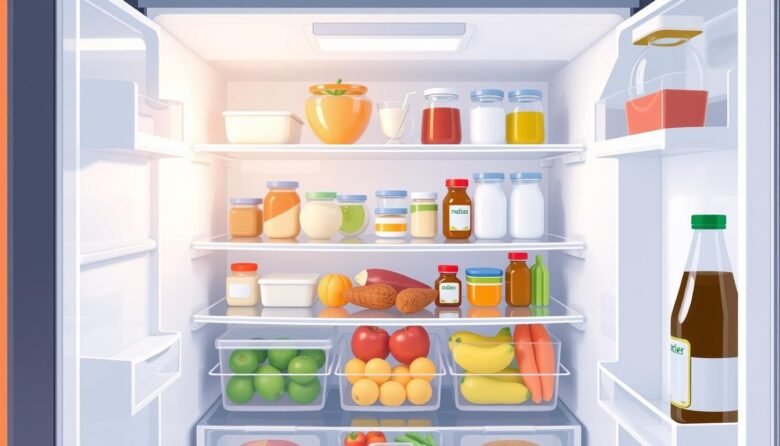A well-arranged refrigerator does more than just look neat. It extends the life of your groceries and reduces spoilage. This means less money wasted and fewer trips to the store.
Proper placement of items maintains quality and safety. Different areas have varying temperatures. Understanding these zones helps prevent bacterial growth.
This guide covers temperature management, shelf optimization, and smart tools. We address common frustrations like forgotten leftovers and spoiled produce. Our systematic approach transforms chaotic spaces into functional areas.
These efforts lead to cost savings and healthier eating habits. They also support environmental responsibility by reducing waste. Let’s explore practical solutions for your kitchen.
Key Takeaways
- Proper fridge organization extends food freshness and reduces waste
- Different temperature zones affect how long items stay fresh
- Strategic placement prevents spoilage and bacterial growth
- Using containers and bins improves space efficiency
- Regular maintenance habits keep your refrigerator organized long-term
- Good organization saves money and supports healthier eating
- Systematic approaches transform chaotic spaces into functional areas
Why Proper Fridge Organization is a Food Safety Essential
Strategic refrigerator arrangement serves as your first defense against foodborne illnesses. This approach prevents bacterial growth and keeps your household safe from contamination risks.
Maintaining the right environment is crucial for preservation. Your cooling appliance should stay at 41°F (5°C) or below. This temperature minimizes pathogen development effectively.
Understanding Your Refrigerator’s Temperature Zones
Different areas within your unit maintain varying chill levels. The back wall and lower sections tend to be coldest. The door shelves experience more temperature fluctuation.
This variation affects where you should position different products. Proper placement ensures optimal safety and extends freshness duration.
The Critical Rule: Storing Food by Cooking Temperature
Arrange items from lowest to highest required cooking heat. Ready-to-eat products belong on the top level. This prevents contamination from drips below.
The second shelf holds items requiring 135°F preparation. Whole cuts of meat needing 145°F go on the third level. Ground meats requiring 155°F occupy the fourth position.
Poultry and other products needing 165°F belong on the bottom. This systematic approach prevents cross-contamination effectively.
How Long Different Foods Actually Last
Various items have different freshness timelines. Ground meats and shellfish remain safe for about two days. Cooked dishes typically last up to four days.
Salads and opened meat products stay fresh for five days. Bacon and smoked sausages can last approximately one week. Unopened packages may remain good for two weeks.
Hard sausages might maintain quality for three weeks. Always discard anything with unusual odor, color, or flavor. Trust your senses when evaluating questionable products.
Power outages present additional safety concerns. Check temperature retention before consuming items after electricity restoration. When in doubt, throw it out to avoid health risks.
These practices reduce waste while ensuring healthy consumption. They transform your cooling unit into a safer environment for all household members.
Mastering the Art of Fridge Organization
The journey toward a perfectly arranged cooling space starts with systematic preparation methods. This approach transforms chaotic areas into functional systems that serve your household efficiently.
Proper arrangement ensures everything remains visible and accessible. It reduces waste and saves time during meal preparation.
The First Step: The Essential Edit and Clean
Begin by completely removing all contents from your appliance. This allows for a comprehensive assessment of what you possess.
Discard any expired products immediately. Check dates on packages and containers carefully.
Wipe all surfaces thoroughly with appropriate cleaning solutions. Pay special attention to shelves and drawers.
This process offers multiple benefits. It improves visibility and maintains hygiene standards.
You gain a fresh start for implementing new systems. Everything becomes easier to manage afterward.
Creating Designated “Containment Zones”
Assign specific areas for different categories within your cooling unit. Group dairy products together in one section.
Create another zone for snacks and quick-grab items. This streamlines access and reduces search time.
Use clear bins and containers to group similar things together. Transparent materials enhance visibility significantly.
This approach prevents forgotten items from lingering in the back. Studies show clear containers reduce food waste by up to 30%.
Label zones with broad terms like “veggies” or “snacks.” This keeps the system adaptable for various products.
Broad categories accommodate changing inventory needs. They work well for households with multiple users.
This method reduces confusion among family members. It encourages consistency in maintaining the system.
You’ll experience efficiency gains during daily kitchen activities. Meal preparation becomes quicker and more enjoyable.
These practices form the foundation for long-term maintenance. They create sustainable habits that benefit your entire home.
Optimizing Your Refrigerator’s Main Shelves
Strategic placement on different levels transforms your cooling appliance into an efficient preservation system. Each area serves specific purposes based on temperature and safety needs.
This method prevents cross-contamination while maximizing freshness. It creates logical flow for daily access and meal preparation.
The Top Shelf: Ready-to-Eat Foods and Leftovers
Position cooked dishes and prepared items on the highest level. This placement minimizes contamination risks from raw products below.
Store yesterday’s dinner and sealed snacks here. These products require no additional cooking before consumption.
Easy visibility ensures you use them before quality declines. This reduces waste and simplifies meal choices.
The Middle Shelves: Dairy, Eggs, and Precooked Items
The center area maintains consistent moderate temperatures. This environment protects sensitive products like milk and cheese.
Eggs belong here in their original carton for protection. Precooked meals also thrive in this stable zone.
This positioning follows the cooking temperature safety rule. It keeps these items safe from raw meat juices.
The Bottom Shelf: Raw Meat, Poultry, and Seafood
Always place uncooked animal products on the lowest level. This contains potential drips and prevents contamination.
Store chicken, beef, and fish in sealed containers. Proper isolation protects everything above from bacteria.
This practice aligns with food safety guidelines for home kitchens. It represents non-negotiable protection for your household.
Regular checks maintain this organized system. Verify products remain in designated zones during routine cleaning.
Proper shelf use improves airflow and reduces clutter. Your cooling appliance works more efficiently this way.
These practices create a safer, more functional kitchen environment. They support both health and efficiency in your home.
Transforming Your Crisper Drawers for Maximum Freshness
The hidden compartment at the bottom of your cooling unit can revolutionize how you store fresh items. These specialized zones maintain optimal humidity levels for different types of edibles.
Traditional compartments often lead to forgotten items lingering in the back. Many households struggle with produce spoilage despite having designated areas.
Should You Use the Drawers? A Case for Clear Bins
Opaque compartments frequently cause visibility issues. Items get lost in the depths, leading to unnecessary waste.
Clear, ventilated containers offer a superior alternative. They provide excellent airflow while maintaining perfect visibility.
Transparent bins allow you to see everything at a glance. This simple change reduces forgotten produce by up to 30%.
Many homeowners completely remove factory drawers. They replace them with customizable clear containers.
This approach lets you create zones based on your household’s needs. You gain flexibility while maximizing available space.
Ethylene Gas: Separating Your Fruits and Veggies
Certain fruits naturally release ethylene gas during ripening. This plant hormone accelerates spoilage in sensitive vegetables.
Apples, bananas, and avocados are major ethylene producers. Leafy greens, carrots, and broccoli are highly sensitive to this gas.
Keeping these items separate extends freshness significantly. Studies show proper separation can double the life of delicate produce.
Designate specific containers for ethylene-producing fruits. Use different bins for ethylene-sensitive vegetables.
This simple separation method reduces waste dramatically. Your kitchen benefits from longer-lasting, better-tasting fresh items.
Proper management of ethylene gas represents a scientific approach to preservation. It transforms how you handle fresh products in your home.
How to Intelligently Organize the Refrigerator Door
The refrigerator door represents the most temperature-variable part of your cooling system. Its frequent opening exposes contents to warmer air, creating an unstable environment for sensitive products.
This area requires strategic thinking for proper item placement. Understanding temperature dynamics prevents spoilage and maintains safety.
What Actually Belongs on the Door Shelves
Condiments and sauces thrive in this fluctuating environment. Their high acid or sugar content resists spoilage effectively.
Ketchup, mustard, and soy sauce handle temperature changes well. Jams, jellies, and pickled items also belong here.
Juices and soda cans work perfectly on door shelves. These beverages maintain quality despite minor temperature shifts.
Clear bins or turntables maximize space efficiency for these products. They create organized zones while improving accessibility.
Items to Keep Off the Door for Safety
Dairy products demand consistent cold temperatures. Milk and cheese spoil quickly when exposed to warmth.
Eggs require stable conditions for optimal freshness. Their porous shells absorb odors and flavors from other items.
Raw meats and leftovers need constant refrigeration. Temperature fluctuations encourage bacterial growth in these products.
Studies show door temperatures can vary by 10-15 degrees. This difference significantly impacts perishable item safety.
Proper door use frees up valuable shelf space for critical items. It creates a safer, more efficient kitchen environment for your home.
Must-Have Tools and Containers for an Organized Fridge
The right equipment transforms your cooling appliance into an efficient system. Smart tools create order and maintain visibility for all household members.
Strategic investments in quality containers pay for themselves through reduced waste. They make daily kitchen activities smoother and more enjoyable.
The Power of Clear, Stackable Bins
Transparent containers revolutionize how you see and access everything inside. You instantly know what you have without moving other products.
Stackable designs maximize vertical space efficiently. They prevent clutter and make retrieval simple without disturbing nearby items.
Use these bins for yogurt cups and cheese blocks. This approach keeps similar things together in visible groups.
Clear bins reduce forgotten items by keeping everything in plain sight. Studies show they cut waste significantly in American homes.
Using Turntables for Condiments and Jars
Lazy Susans solve the problem of lost sauces and dressings. A simple spin reveals everything stored on these rotating platforms.
They work perfectly for condiments, small jars, and beverage containers. No more digging through crowded door shelves to find what you need.
Place a turntable in your kitchen for easy access to frequently used products. This small change brings big convenience to meal preparation.
Labeling for Accountability and Efficiency
Simple labels create clear zones for different categories. Use broad terms like “dairy” or “produce” to designate areas.
This system helps everyone in the home maintain order consistently. People know exactly where to return items after use.
Labels work with bins, drawers, and shelves throughout your cooling space. They establish logical placement patterns that reduce confusion.
These tools represent affordable solutions for any household budget. They support long-term maintenance of your efficient kitchen system.
Building Habits to Maintain Your Organized System
Creating an efficient cooling system requires consistent daily practices. These routines ensure your efforts deliver lasting results for your household.
Simple habits prevent backsliding into chaos. They transform maintenance from a chore into an effortless part of your routine.
Implementing the “First-In, First-Out” Rule
The FIFO method ensures older products get used before newer ones. Always place recent purchases behind existing items.
This approach prevents forgotten goods from expiring unnoticed. It represents a fundamental principle for reducing waste.
FIFO reduces spoilage by up to 25% in typical American homes. This simple practice saves money while keeping your kitchen efficient.
The Benefit of Prepping Snacks and Ingredients
Preparing portions ahead streamlines daily routines. Washed and cut veggies stand ready for quick meals.
Pre-portioned snacks encourage healthier choices. They reduce impulse eating and save valuable time.
This practice minimizes frantic searches during busy moments. Everything remains visible and accessible when needed.
Regularly Checking for Spoilage and Expirations
Weekly audits identify problematic products before they affect others. Designate a specific day for this quick review.
Sunday evenings work well for many households. This routine takes less than five minutes but delivers significant benefits.
Immediately discard anything showing mold or unusual odors. This prevents bacterial spread to other items.
These maintenance habits preserve your system’s integrity. They ensure your cooling appliance remains functional and efficient.
Enjoying a Fresher, More Efficient Kitchen
Implementing these smart strategies transforms your kitchen experience completely. You’ll enjoy longer-lasting freshness and significantly reduced waste.
Proper temperature management and strategic zoning create a sustainable system. Using clear containers and designated areas maintains order effortlessly.
Small changes deliver substantial results when applied consistently. Regular checks and the FIFO method preserve your progress effectively.
This approach reduces stress while promoting healthier eating habits. You’ll save money and contribute to environmental responsibility.
Begin today with simple adjustments using these practical methods. Your organized space will become a source of daily satisfaction.



